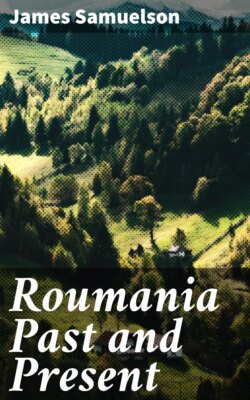Читать книгу Roumania Past and Present - James Samuelson - Страница 12
На сайте Литреса книга снята с продажи.
III.
ОглавлениеBut we must dwell no longer in this realm of fruitfulness, and must pass on to the alpine regions beyond. In so doing we change our altitude much more rapidly than heretofore, and as we travel through the ascending valleys into the pine-clad rocks and mountains it is difficult to know with what European highlands to draw a comparison. 'Is it Wales?' the English reader will naturally enquire. 'No, for the mountains are too sharp and rocky, and yet not nearly so barren as those of our principality.' 'Are we in the Pyrenees?' Certainly not; the vegetation is not so rich, few waterfalls are visible, and there is a slovenly appearance about the clayey or sandy surface, reddened here and there by ferruginous streamlets, and covered with weedy-looking brushwood which is quite at variance with the sloping gardens of the sunny south of France. Is the scenery Dolomitic? In a sense it is. The summits of the mountains are often very jagged, Rosszähne or horses' teeth, as they are called, but they are dark grey and not white or yellow as the Dolomites. The trees are the same as in other alpine lands, firs, pines, larch, and birch growing thickly to a height of about 5,000 or 6,000 feet above the sea-level; then come grass and alpine flowers, and finally the rough jagged summit. Whatever region it may resemble, and perhaps its nearest analogues are the wilder portions of the Bavarian Alps or the less rugged parts of the Tyrol, it is lovely and romantic, and needs only to be visited by a few Western tourists to become an extension of the playground of Europe; for, in combination with beautiful scenery, there are charming costumes, primitive manners, and some interesting phases of Oriental life. And should his way lead him to Sinaïa, the summer residence of the Court, and the sanatorium to which the people of Bucarest resort, not as yet in too great numbers, the visitor will readily admit that there are few spots in Europe better calculated to afford rest and refreshment to the wearied mind.[12]
Sinaïa presents many attractions for the tourist. Nestling on the slopes of hills at the junction of three valleys, and immediately surrounded by mountains which vary in height from 3,000 to 8,000 or 9,000 feet above the sea-level, and are easily accessible to an ordinary mountaineer, it consists of a fine old monastery, the temporary residence of the Court, two good old-fashioned hotels, and a large number of pretty villas, the property of wealthy landed proprietors, officials, and merchants of Bucarest. There is a casino, or reading-room, and small concert hall, a beautiful bathing establishment, and a garden in which a military band discourses lively and lovely music every evening within hearing of the guests whilst they are at dinner under verandahs in front of the hotels. The monastery is situated upon a high hill approached from the valley below by sloping walks and drives, and it consists of two large curtilages surrounded by low dwellings, which were formerly (and are still to some extent) occupied by monks, and now serve as the residences of the Court and its attendants. The two curtilages are really one divided across the centre, and in each division is a small Byzantine church, in which the service of the Orthodox Greek faith is conducted. At the further extremity of the convent are the apartments of the King and Queen, and it is hardly necessary to add that everything is done to render this old building suitable for the abode of royalty.[13] At the side of the monastery is a verdant plateau, from which there is a beautiful view, and whereon the peasantry, as well as many officers and ladies of the Court, may be seen, usually on Sunday afternoon, dancing the national dances of the country, and more particularly the national dance, the 'Hora,' of which some account will be given hereafter. Behind the monastery a small valley penetrates into the mountains. This valley is, in reality, an extensive wood, containing some magnificent forest trees and replete with ferns and wild flowers, whilst through the centre of it a river rushes headlong, forming, as it descends, three beautiful cascades, the last or highest being surmounted by a towering rock, to ascend which, alone, is a good morning's healthful enjoyment. Behind this rock rise the Carpathian peaks, Caraïman, Verful, &c., and from the summits of these, which may be reached in two or three hours, it is said that on a clear day the distant Balkans are visible across the Danube.
But if Sinaïa, with its surroundings, is beautiful to-day, what will it be in the future? Close to the railway station, on a conspicuous eminence, a magnificent hotel is in course of erection to meet the wants of the increasing number of visitors. At present the King only possesses, besides his temporary residence in the monastery, a small châlet known as the 'Pavilion de Chasse,' situated in the woods behind the monastery. Although this is externally an unassuming little villa, the interior is beautifully decorated with carved oak, and is furnished with exquisite articles of the same material, and generally with a taste for which the first lady of the land is so widely reputed. But the King is also erecting, in a favoured situation close at hand, a beautiful summer palace, which will command a magnificent view of the surrounding scenery; and there he and his Queen will no doubt continue, as they do in their temporary residence, to dispense a generous hospitality to visitors, and to secure goodwill and popularity amongst their subjects.[14]
But we must apologise for this digression, and return to our general survey.
